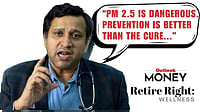Inn today’s unpredictable world, we’ve learned a hard truth — life can change in a heartbeat. From the COVID-19 pandemic to rising lifestyle diseases and sudden unprecedented life event, uncertainties are everywhere.
While we can’t control when hardship strikes, we can control how prepared we are. Insurance is the safety net that cushions the blow. Yet, despite growing awareness, the protection gap for Indians is a staggering 83%, as per the Swiss Re, “Closing Asia’s Mortality Protection Gap 2020” report. This hidden gap often leaves families exposed to financial hardship when they need support the most.
What Does “Underinsured” Mean?
The core purpose of life insurance is to financially protect your loved ones in your absence — by replacing lost income, repaying debts, and supporting long-term goals like children’s education or retirement.
Being underinsured means that your policy coverage is insufficient to meet these actual financial needs.
For example, consider Raj, a 35-year-old professional with a ₹50 lakh policy. At first glance, this seems adequate. However, his family has a ₹70 lakh home loan and additional living expenses. In his absence, the insurance coverage couldn’t cover all liabilities – leaving his family financially vulnerable despite having insurance.
Common Reasons for Being Underinsured
Several common reasons contribute to underinsurance:
Financial Priorities - People often prioritize immediate expenses over insurance, limiting the funds available for adequate coverage. This can leave them vulnerable when unexpected events occur.
Overreliance on employer policies: Group insurance provided by employers may be insufficient and may end if you change in jobs or become self-employed.
Outdated policies: Life changes — marriage, children, loans — are often not reflected in existing insurance coverage.
Diminishing value of money: Over time, the real value of your insurance cover diminishes due to factors like increasing medical, education costs and the value of money decreasing with time’.
Tax-saving mindset: Many buy insurance mainly for tax benefits (Section 80C), not actual protection.
Risks of insufficient insurance coverage
Underinsurance can have serious, lasting consequences:
Financial strain: Families may struggle with daily expenses, EMIs, and school fees.
Lifestyle compromises: May be forced to downsize homes, change schools, or delay medical care.
Emotional stress: Financial worries add to the grief of loss.
Dependence on others: Families may need support from relatives or external sources.
Sacrificed dreams: Children’s education, marriage plans, and retirement plans may remain unfulfilled.
Simply put, underinsurance can be as dangerous as being uninsured, offering a false sense of protection until a crisis exposes the shortfall.
How to Bridge the Protection Gap Avoiding underinsurance involves a few practical steps:
Assess your real needs: Aim for a life cover of 10–15 times your annual income, accounting for debts and future financial commitments.
Review insurance coverage regularly: Update your policy after major life events like marriage, childbirth, home loans, or job changes, ideally every two years.
Opt for Pure protection plans: Term plans provide high coverage at affordable premiums, consider riders for critical illness or disability to enhance protection.
Start early: Younger applicants benefit from lower premiums and easier underwriting.
Don’t rely solely on employer cover: Group policies are temporary and usually insufficient for long-term protection.
Seek professional advice: A financial advisor can help tailor your insurance to your evolving needs.
Conclusion
Insurance is not just a policy, a checkbox or mere paperwork— it’s a promise to protect those you love. Instead of asking, “Do I have insurance?” ask yourself: “Is my insurance enough to protect my family?”
Remember, true financial planning isn’t just about you — it’s about everyone you care for.
Disclaimer: The Views are Personal and not a part of the Outlook Money Editorial Feature













